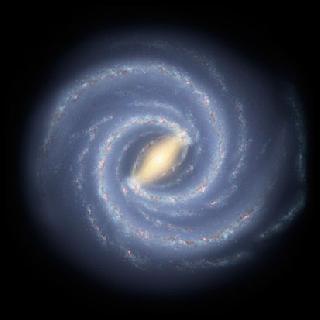
The Milky Way. A NASA photo
WASHINGTON (PTI): Two powerful collisions with a dwarf galaxy in the past two billion years may have been the cause of the spiral arm structure of our Milky Way, scientists say.
The new findings, published in the journal Nature, hint that impacts with even relatively small galaxies have played an important role in shaping galactic structure throughout the Universe.
In trying to explain the shape of our own galaxy, the Milky Way, with its prominent spiral arms rooted in a central bar, scientists have traditionally dismissed the influence of outside forces, although astronomers have seen shape-changing mergers of other galaxies.
But in the new study, scientists focused on the nearby Sagittarius dwarf galaxy, much of which had been ripped apart by the gravitational pull of the Milky Way, leaving debris that forms a huge but very faint stream of stars around our galaxy, LiveScience reported.
Altogether, this dwarf galaxy might have once been far more substantial, maybe 100 times more massive, they found.
“Sagittarius was among the largest of the Milky Way’s dwarf satellites before it began to be torn apart by galactic tides, but objects on that scale are still relatively small details in the eyes of many galaxy-formation theorists,” said study lead author Chris Purcell, an astrophysicist at the University of Pittsburgh.
“It had always been assumed that the Milky Way had evolved relatively unperturbed over the past few billion years in terms of its global structure and appearance.”
However, in computer simulations, the scientists found this dwarf galaxy’s collision with the Milky Way might have had dramatic consequences.
It may have triggered the formation of our galaxy’s spiral arms, caused the flaring seen in the outermost disk, and influenced the growth of its central bar.
The models, the scientists said, showed that the impact could have generated ring-like structures wrapping around the Milky Way, similar to ones actually seen in our galaxy, such as the Monoceros ring.
Astronomers have seen mergers of galaxies with smaller companions, known as minor mergers, and mergers of galaxies of equal mass, so-called major mergers.
Minor mergers such as that of the Milky Way and the Sagittarius dwarf galaxy are expected to be far more common than major mergers.
“We may well learn to generally view intermediate-scale spirality in systems like the Milky Way as transient symptoms of recent impacts involving satellites too faint to see,” said Purcell.
“Future observations of nearby galaxies may even begin to discern the brightest of such companions, which will help solidify the phenomenological link between minor mergers and spiral arms.”
 Previous Article
Previous Article Next Article
Next Article











The Indian Air Force, in its flight trials evaluation report submitted before the Defence Ministry l..
view articleAn insight into the Medium Multi-Role Combat Aircraft competition...
view articleSky enthusiasts can now spot the International Space Station (ISS) commanded by Indian-American astr..
view article